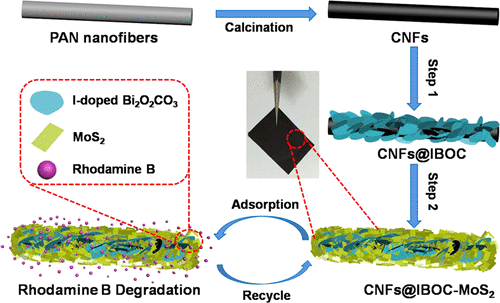当前位置:
X-MOL 学术
›
ACS Sustain. Chem. Eng.
›
论文详情
Our official English website, www.x-mol.net, welcomes your
feedback! (Note: you will need to create a separate account there.)
Recyclable Carbon [email protected] I-Doped Bi2O2CO3–MoS2 Membranes for Highly Efficient Water Remediation under Visible-Light Irradiation
ACS Sustainable Chemistry & Engineering ( IF 7.1 ) Pub Date : 2018-01-17 00:00:00 , DOI: 10.1021/acssuschemeng.7b04270 Jundie Hu 1 , Dongyun Chen 1 , Najun Li 1 , Qingfeng Xu 1 , Hua Li 1 , Jinghui He 1 , Jianmei Lu 1
ACS Sustainable Chemistry & Engineering ( IF 7.1 ) Pub Date : 2018-01-17 00:00:00 , DOI: 10.1021/acssuschemeng.7b04270 Jundie Hu 1 , Dongyun Chen 1 , Najun Li 1 , Qingfeng Xu 1 , Hua Li 1 , Jinghui He 1 , Jianmei Lu 1
Affiliation

|
Unique hierarchical photocatalytic carbon nanofibers (CNFs)@I-doped Bi2O2CO3–MoS2 membranes were designed and fabricated and applied for efficient water remediation under visible-light irradiation. First, I-doped Bi2O2CO3 nanosheets were uniformly decorated on the surface of CNFs. The introduction of iodine element resulted in narrowing of the bandgap of Bi2O2CO3 because CO32– was partly replaced by I–, thereby enhancing the absorption intensity of the photocatalyst to visible light and improving its photocatalytic efficiency. Subsequently, thinner MoS2 nanoflakes were also modified on the surface of the CNFs and in the gaps between the I-doped Bi2O2CO3 nanosheets using a hydrothermal method; this modification was beneficial to electronic transmission and prevented the rapid recombination of photogenerated electron–hole pairs. This new photocatalytic [email protected] Bi2O2CO3–MoS2 nanocomposite exhibited excellent photodegradation ability for eliminating the refractory pollutant Rhodamine B (RhB) from wastewater. Complete degradation of 50 mL of RhB (1.0 × 10–5 M) was achieved using 50 mg of [email protected] Bi2O2CO3–MoS2 within 5 min. Moreover, the photocatalyst membrane was stable and recyclable after multiple runs. All of these factors demonstrate the potential application of this photocatalyst in the removal of RhB from wastewater.
中文翻译:

可回收碳[受电子邮件保护]掺I的Bi 2 O 2 CO 3 -MoS 2膜,用于可见光照射下的高效水修复
设计和制造了独特的分层光催化碳纳米纤维(CNFs)@I掺杂的Bi 2 O 2 CO 3 -MoS 2膜,并将其应用于可见光照射下的有效水修复。首先,将掺杂I的Bi 2 O 2 CO 3纳米片均匀地装饰在CNF的表面上。碘元素的引入导致Bi 2 O 2 CO 3的带隙变窄,因为CO 3 2 –被I –部分取代。从而增强了光催化剂对可见光的吸收强度并提高了其光催化效率。随后,也使用水热法在CNF表面和I掺杂Bi 2 O 2 CO 3纳米片之间的间隙中修饰了更薄的MoS 2纳米薄片。这种修饰有利于电子传输,并阻止了光生电子-空穴对的快速复合。这种新型的光催化[受电子邮件保护] Bi 2 O 2 CO 3 –MoS 2纳米复合材料具有优异的光降解能力,可消除废水中的难降解污染物若丹明B(RhB)。使用50 mg [受电子邮件保护的] Bi 2 O 2 CO 3 -MoS 2在5分钟内可以完全降解50 mL RhB(1.0×10 –5 M)。而且,光催化剂膜在多次运行后是稳定的且可回收的。所有这些因素证明了这种光催化剂在从废水中去除RhB的潜在应用。
更新日期:2018-01-17
中文翻译:

可回收碳[受电子邮件保护]掺I的Bi 2 O 2 CO 3 -MoS 2膜,用于可见光照射下的高效水修复
设计和制造了独特的分层光催化碳纳米纤维(CNFs)@I掺杂的Bi 2 O 2 CO 3 -MoS 2膜,并将其应用于可见光照射下的有效水修复。首先,将掺杂I的Bi 2 O 2 CO 3纳米片均匀地装饰在CNF的表面上。碘元素的引入导致Bi 2 O 2 CO 3的带隙变窄,因为CO 3 2 –被I –部分取代。从而增强了光催化剂对可见光的吸收强度并提高了其光催化效率。随后,也使用水热法在CNF表面和I掺杂Bi 2 O 2 CO 3纳米片之间的间隙中修饰了更薄的MoS 2纳米薄片。这种修饰有利于电子传输,并阻止了光生电子-空穴对的快速复合。这种新型的光催化[受电子邮件保护] Bi 2 O 2 CO 3 –MoS 2纳米复合材料具有优异的光降解能力,可消除废水中的难降解污染物若丹明B(RhB)。使用50 mg [受电子邮件保护的] Bi 2 O 2 CO 3 -MoS 2在5分钟内可以完全降解50 mL RhB(1.0×10 –5 M)。而且,光催化剂膜在多次运行后是稳定的且可回收的。所有这些因素证明了这种光催化剂在从废水中去除RhB的潜在应用。











































 京公网安备 11010802027423号
京公网安备 11010802027423号